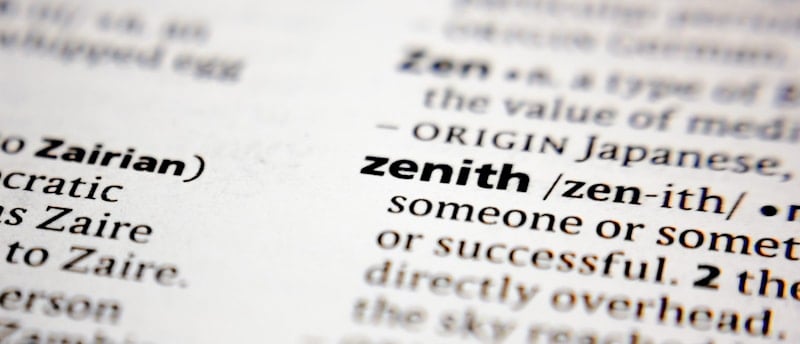Besides Latin, the English language has taken inspirations from a few other ancient languages to populate its huge repository of words and phrases. However, most of them have undergone modifications and refinements before making their way into the English lexicon. The word “zenith” is one such highly modified loanword.
To properly use “zenith” in a sentence, make sure you know the term has both literal and figurative meanings. It could mean the highest point in the sky or the peak or strongest period in one’s life. If using the word in non-astronomy texts, make sure the word denotes strength and prosperity.
Keep reading to learn more about the word’s meaning, its history, origin, etc. In the latter part of this article, there is also a fairly long list of sentences incorporating the word to help you better understand its usage in various writing scenarios.

“Zenith” – Definition & Usage History
Literally speaking, the term “zenith” means the highest point in the heavens attained by any celestial body (moon, sun, etc.). In figurative speech or “formal” language, however, the word means the point of culmination or the most successful or strongest period. Other words that have a similar meaning include apex, crescendo, meridian, summit, pinnacle, etc. The opposite of “zenith” is “nadir”, which means “the very bottom”.
History
The term “zenith” is the inaccurate reading of “samt al-ras”, an Arabic expression that roughly translates to “the path above one’s head” or “direction of the head”. Over the years, the term tread through varied cultures and societies, including Old Spanish, Middle French, and Medieval Latin before making its foray into the English language.
The voyage resulted in the word being truncated as “samt” (which means direction) somewhere during transit. It was also at times miswritten as “cenit/senit”, the letter “m” being incorrectly replaced with “ni”.
Thanks to “cenith”, the Old French version of the word, “zenith” was born or derived. In English, the word has been used since the 1300s, with speakers using the term to denote the highest celestial point. By the 1600s, the term was used to indicate other high points in general too.
Naming Babies “Zenith”
The name Zenith is used by parents looking for a non-gendered or unisex name for their child. The name is not extremely common or popular, but that rarity also adds to its overall charm. The regions where babies get named Zenith primarily are Arabic and English-speaking countries.
In other regions of the world, names that sound similar to “zenith” or have a letter or two interchanged could be used. For instance, in Sri Lanka, the name “Senith” is not rare. Menith, Zeenath, etc. are other names that may or may not have been inspired or derived from “zenith”. The name “Zeenath” is more likely to have taken inspiration from the word “zenith” because “zenith” is pronounced as “zee-nuhth”.
How To Properly Use “Zenith” In A Sentence
When the word “zenith” is used in a sentence, it indicates being at the top, the summit, the pinnacle, or the peak. For example, if you’re stating someone is at the peak of their career, you use the word “zenith” to stress that point. For example:
- Tim’s third promotion in two years clearly indicates him being at the zenith professionally.
- Her career is currently at its zenith.
If you’re using the term taking its literal meaning into consideration, use it only in sentences that talk about the sky, space, celestial bodies, etc. For example:
- The sun hit its zenith and steeply fell to the west, and they didn’t notice.
- Once the sun was at its zenith, it became a bit too hot for travel or to even move.
The term is also used in sentences to denote the maximum strength or potential of a thing, event, occurrence, etc. For example:
- The link between patriotism and archaeology reached its zenith during this time.
Usage Of The Term In Astronomy
The celestial sphere has no ending point. The peak or highest point that “zenith” indicates, therefore, is imaginative. The point is usually opposite or the farthest from the earth’s gravitational pull. In astronomy, when the term is used to say the sun is at its zenith, it supposedly denotes the positioning of the sun in the sky.
In astronomy texts, the sun or any celestial body has no zenith. However, to people not familiar with spatial studies, the sun is at its zenith when it’s directly overhead or when it’s noon. In space, the distance between the supposed zenith and a celestial body is referred to as “zenith distance”.

Using Zenith In Its Adjective Form
The term “zenith” is a noun. Its adjective form is “zenithal”. The word “zenithal”, quite obviously, means near or located at the zenith. The plural form of the term is “zeniths”.
The adjective didn’t come into use with its noun form. It took at least a couple of centuries for the adjective to be coined (by nobody knows who) and enter into circulation. Here are sentences with the adjective in them:
- A dark cloud-wall is erected around the horizon, but the zenithal sky is clear.
- It is quite evident that zenithal projections and perspective are specific conical projection groups.
Kindly note, the word is not commonly used. If you, therefore, found the term a bit off, you are not alone and not necessarily wrong.
Example Sentences With The Word “Zenith”
Here is a list of sentences incorporating the word “zenith”:
- The year marked the zenith of Egyptian history and culture.
- He was at the absolute zenith of his career as a chef.
- The zenith of the country’s postwar hegemony happened during the 1990s.
- What made you look up the word “zenith”?
- The sun rises, hits its point of zenith, and sets.
- Until the team reaches its zenith, the performance quality will continue to be used as a barometer of efficiency.
- Her publicity campaign hit its zenith when she was invited to the royal family gathering.
- The tragedy will certainly hit its zenith during next month’s finale episode.
- The war represented her career’s zenith but also resulted in her inexorable decline.
- By the end of the century, most global empires had hit their zenith.
- The trend of freebies and massive discounts has certainly reached its zenith, thanks to the changing market trends.
- If the project gets done to the client’s specifications, she will most likely be at the zenith of her tech career.
- The method requires data gathered from the two satellites, one near its zenith and another in the horizon’s direction.
- If technology can be considered the peak of modernity and sophistication, nuclear technology should be the zenith or highest manifestation of that technology.
- Since her energy is at its zenith during mornings, she likes to get done with larger tasks during that time.
- After the prime minister ended the war, the admiration for him among the people hit its zenith.
- Before his zenith ended, Jason published five best-selling books.
The Sun And The Zenith Passage
Throughout a year, the sun’s route across the sky changes continually. During summer, the sun is at its highest point in the sky. It is at a relatively low position in the sky during winter. These alterations in positioning have a basic cause, which is the titling of the earth’s rotation axis.
During summer, the North Pole in the Northern Hemisphere is tilted more than usual toward the sun. As a result, the sun shines a lot more directly in the region in summer than during any other time of the year. With the earth spinning, areas in the region stay sunlit longer than usual, which means days tend to last long. The longest day is referred to as the summer solstice, which usually falls on or around June 21 every year.
At two distinct points in the orbit, the North Pole neither points toward the sun nor away from it. These two points, referred to as equinoxes, fall at around 21st March and September 21, respectively. On those two days, the amount of daytime and nighttime are equal everywhere on earth – 12 hours each.
Once or two times a year, people living at lower latitudes (within around 24 degrees of the earth’s Equator) could see the sun reaching the zenith. When a pencil is poked straight into the ground during the sun’s “zenith” positioning, the pencil will have no shadow. The path taken by the sun during these days—starting from sunrise, passing through zenith, and concluding at sunset—is referred to as the zenith passage.
At the planetary equator, the passage of the zenith overlaps with the equinoxes. At Chichen Itza, a Mayan complex of ruins in Mexico, the zenith passage can be experienced on or around 26th May and 20th July. Apparently, these zenith events are believed to have played a major role in Mayan calendar development.
Conclusion
Besides getting the meaning of “zenith” wrong or the context in which it should be used, some also get the spelling incorrect since the word doesn’t sound like what its spelling might suggest. Therefore, when using the term in a sentence, pay attention to how you spell the word. Not to mention, you can always use alternative words or synonyms if the need to use “zenith” arises multiple times in a paragraph.
Shawn Manaher is the founder and CEO of The Content Authority. He’s one part content manager, one part writing ninja organizer, and two parts leader of top content creators. You don’t even want to know what he calls pancakes.

